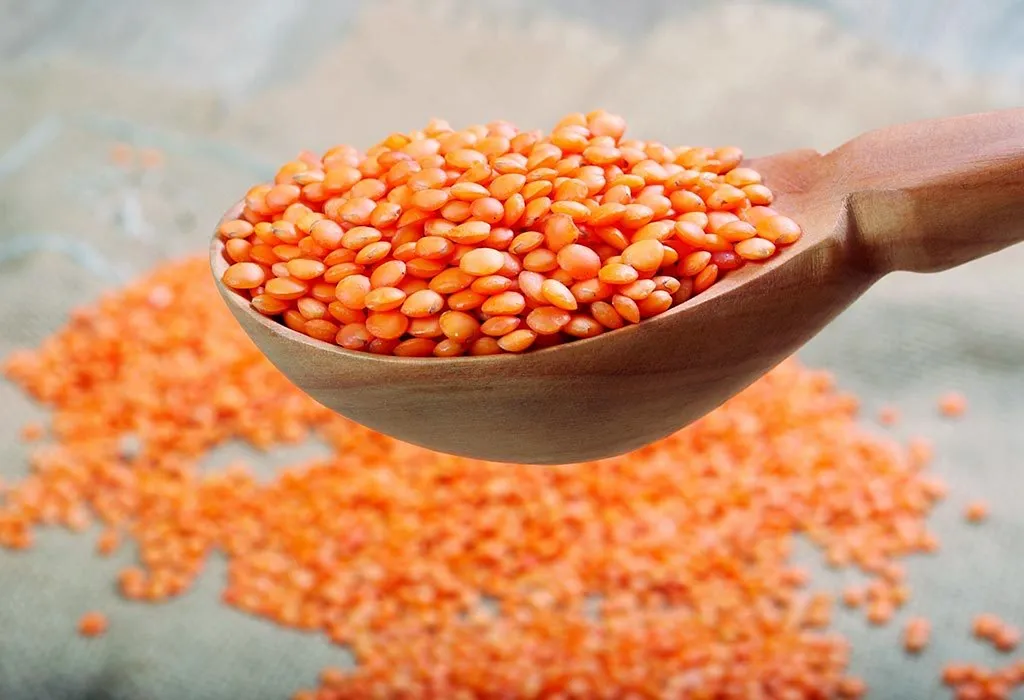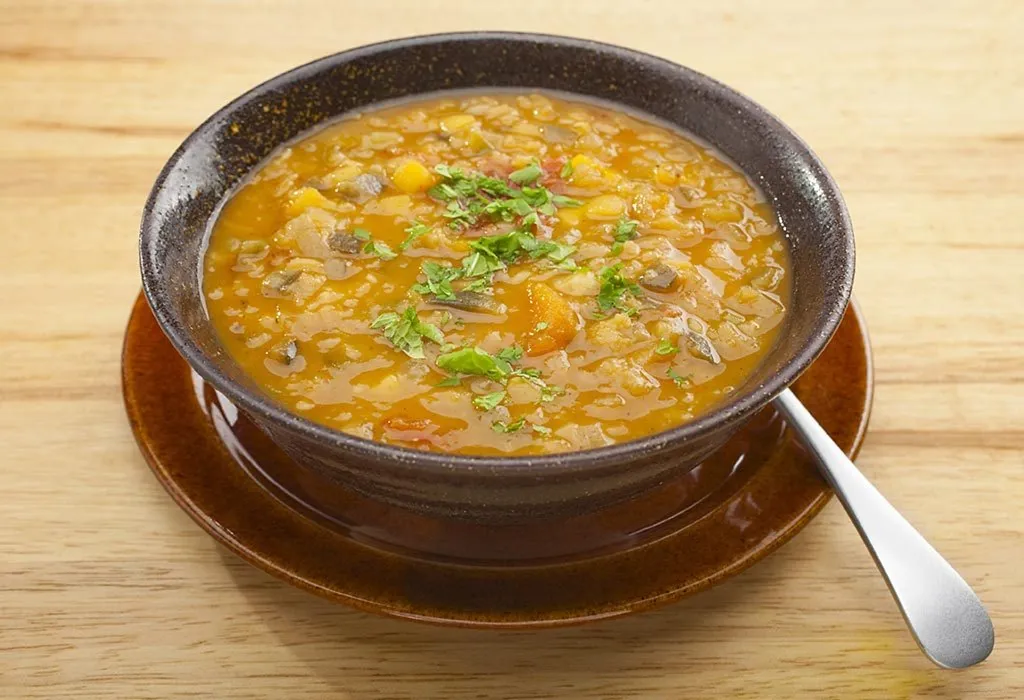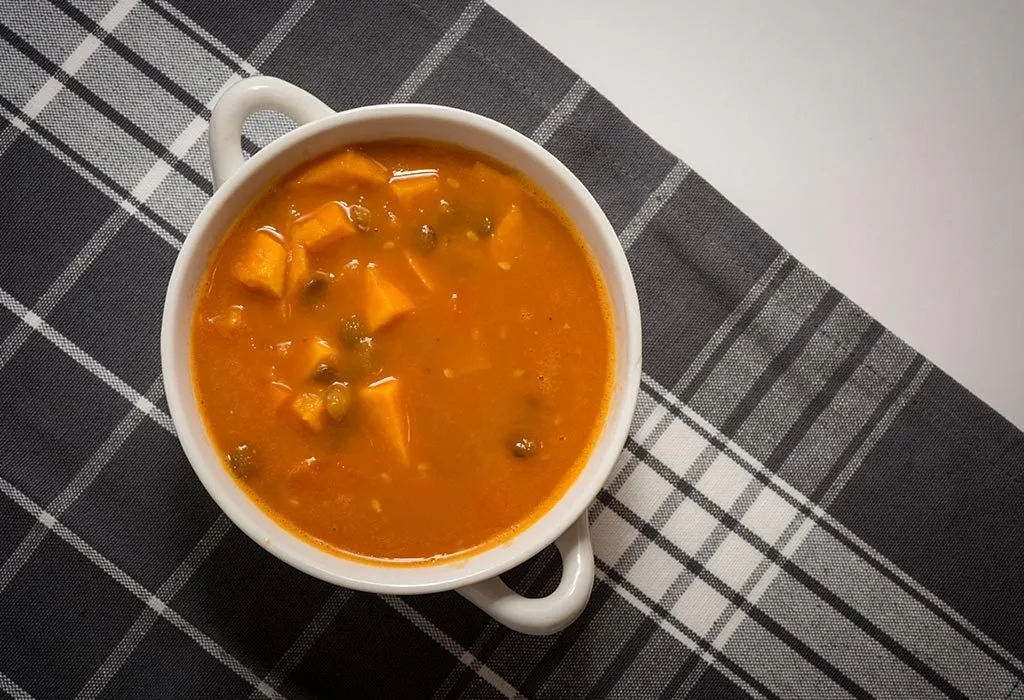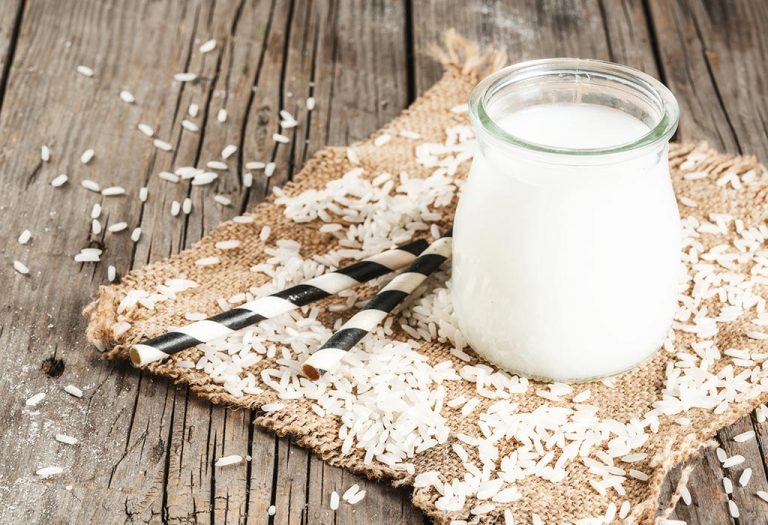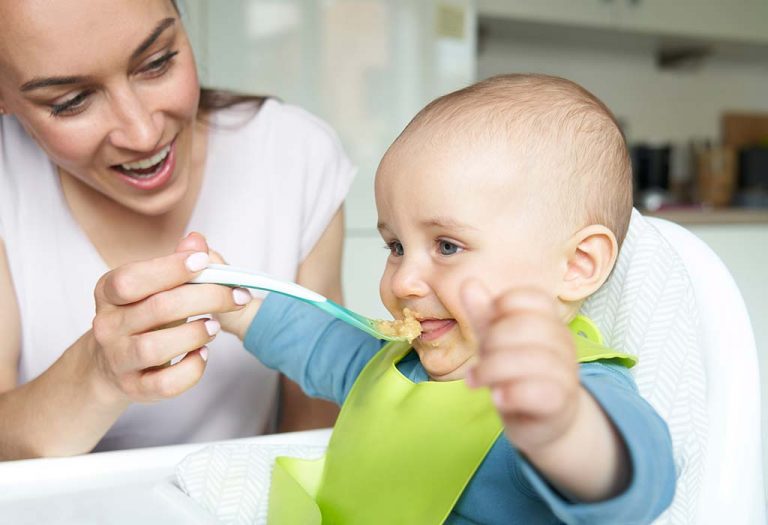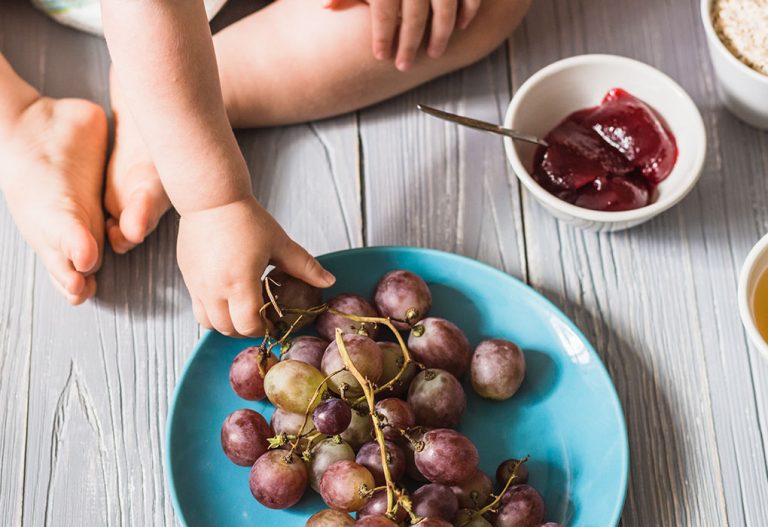Lentils for Babies – When to Introduce, Benefits and Recipes
When introducing solid foods to infants, typically, parents start with simple fruit or vegetable purees, which are gentle on the baby’s developing digestive system. However, expanding beyond these basics, have you considered incorporating lentils into your baby’s diet? Particularly, moong dal is good for babies. This type of lentil is not only easy to prepare, which appeals to busy parents, but it is also packed with essential nutrients beneficial for your baby’s growth and development. Including ‘lentils for infants’ in their diet can provide nutrients, making it a wholesome choice. The question remains, should you give dal to your baby? Keep reading.
When Can Infants Eat Lentils?
The best age to introduce your baby to the world of lentils is somewhere between 9 and 11 months. Some parents prefer starting it off as early as 6 months but that usually results in discomfort to the baby. Lentils tend to contain a lot of protein and fibres, which the baby’s stomach is not prepared to digest at such a young age. It is also better if you restrict the introduction of solids to one food item at a time so that your child does not get overwhelmed when so many different tastes are introduced, and you can keep a good eye on how his body responds to each one of them.
Nutritional Facts of Lentils
Giving masoor dal to babies, along with other lentils can be very beneficial for your baby. A half a cup of lentils that have been boiled and cooked plainly consists of the nutrients given below.
| Description | Quantity (per 100 g) |
| Protein | 25.8 g |
| Sugar | 2 g |
| Fibre | 30.5 g |
| Carbohydrates | 60 g |
| Sodium | 6 mg |
| Energy | 353 calories |
| Folate | 479 mcg |
| Iron | 7.5 mg |
Health Benefits of Lentils for Babies
Feeding lentils to your baby has its own share of benefits that support his physical development as well as his general well-being.
1. Helps in the Development
Folate is one of the key nutrients that pregnant mothers are strongly advised to include in their diet as it supports the neurological development of the foetus. Lentils are a good source of folate. Even after delivery, folate is highly essential for a baby’s growth since it works with bodily processes to create new cells and enhance the internal development of various regions (1).
2. Strengthens the Immune System
A strong immune system can protect the baby from harmful infections and ensure his healthy development. Your can include lentils in your baby’s diet to strengthen his immune system. Lentils are also a good source of zinc, which improves the immunity of the baby (2).
3. Provides Energy
Half a cup of lentils can provide nearly 120 calories. Combined with that, the presence of iron within them is substantial, too. As a baby crosses the 6-month mark, a lot of iron reserves in his body are used up in the rapid pace of development, which gives rise to the need of external iron sources to replenish them. Lentils work wonders in this regard, bringing back revitalizing energy for the body and making sure the baby stays active.
Which Types of Lentils Are Best for Babies
It can get difficult to decide which dal is good for babies since lentils come in a wide variety. Find out which lentils you should choose for your little one.
- Red lentils are great for lentil soup for baby and purees since they have low fibre content in them. Red lentils are smooth and can be prepared quickly.
- For older babies, green lentils are a good option. However, it is suggested that you don’t opt for canned lentils since these can easily cause gas problems in babies.
How to Choose Lentils for Baby?
Once you buy the best dal for baby, make sure you check them for any stones or dirt in them. Following that, wash them thoroughly under running water (3).
How to Cook Lentils for Infants?
Preparing lentils for baby is a simple process and takes very less time.
- It is not necessary to soak lentils overnight but it can make it easy to cook them.
- Pressure cook the lentils for three whistles. Turn off the flame once done and let it cool. Mash the lentils well before giving it to your baby.
Can Lentils Cause Gas in Babies?
Lentils do have complex sugars that can be difficult to digest and may result in gases. However, some babies do manage to digest them well and have no such issues.
Lentil Recipes That You Can Try
There are some tasty food recipes that you can prepare using lentils that your baby will like, giving him all the healthiness he needs from them.
1. Lentil and Apricot Soup
Lentil and apricot soup is one of the best dal soups for babies. Here is how you can make it.
Ingredients
- Chopped apricots – 1 cup
- Cumin seeds – 1 tsp
- Chopped onion – 1
- Diced carrot – 1
- Red lentils (cooked) – 1 cup
- Olive oil – 1 tbsp
- Water
How to Make
- Heat some oil in a pan. Add cumin seeds, chopped carrots, and onions to it, and sauté on a low flame for about 10 minutes.
- Follow up with cooked lentils and considerable water. Later, simmer it and let it cook for about 10 minutes.
- Once done, let it cool. Transfer it to a blender and run it all the way until it forms a smooth soupy texture. Add in the apricots at this stage, blend once more, then pour it in a bowl to serve.
2. Lentil Curry
As your baby begins to enjoy the solid texture and taste of lentils, you can introduce him to a better version with this baby lentil recipe.
Ingredients
- Lentils – 1 cup
- Tofu cubes – 1 cup
- Oil – 1 tbsp
- Cloves – 4-5
- Garlic paste – 1 tsp
- Diced carrot – 1
- Chopped onion – 1
- Turmeric – 1 tsp
How to Make
- Cook lentils in a pressure cooker for up to 3 whistles.
- Heat some oil in a pan, add the cloves, garlic paste, and other vegetables, and sauté them well. Once done, add the tofu cubes and give it a nice stir.
- Next, add lentils and a pinch of turmeric.
- Stir this mixture together till it gets a good curry-like consistency.
3. Lentil Soup With Sweet Potatoes
The taste of sweet potatoes can make it easier for your little one to accept lentils and start wanting more of it right away.
Ingredients
- Lentils (toor dal) – 1 cup
- Cumin seeds – 1 tsp
- Diced sweet potato – 1
- Water as required
How to Make
- Heat some oil in a pressure cooker, add cumin seeds and once they change colour, add lentils and sweet potatoes and sauté well. Add water and close the lid and let it cook.
- Once cooked, mash the ingredients or blend to form a soupy mixture.
- Strain using a sieve and feed soup to your baby.
4. Lentils and Vegetable Puree
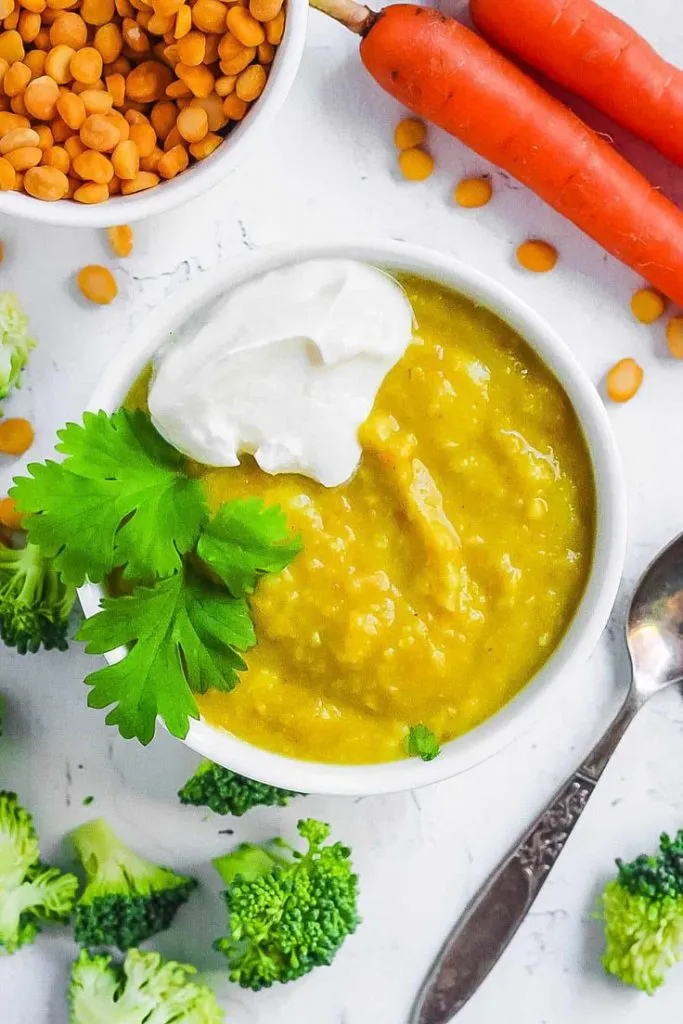
Source: Pinterest
Babies can swallow lentils and vegetable puree easily and it will also be light on their stomach.
Ingredients
- Vegetable broth – 1 cup
- Lentils (cooked) – 1 cup
- Chopped onion – 1
- Diced sweet potato – 1
- Chopped tomato – 1
- Green peas (boiled) – 1 cup
- Oil – 1 tbsp
How to Make
- Heat some oil in a pan and add the onions, and sauté well. Follow up with tomatoes and cook them for a few minutes. Add the broth to this mix and cover it with a lid.
- Let it cook on a low flame for about 10 minutes. Add the peas, sweet potatoes, and lentils and mix well.
- Turn off the flame and let it cool.
- Next, transfer it to a blender and blend until smooth to form a puree.
5. Creamy Lentil and Spinach Puree
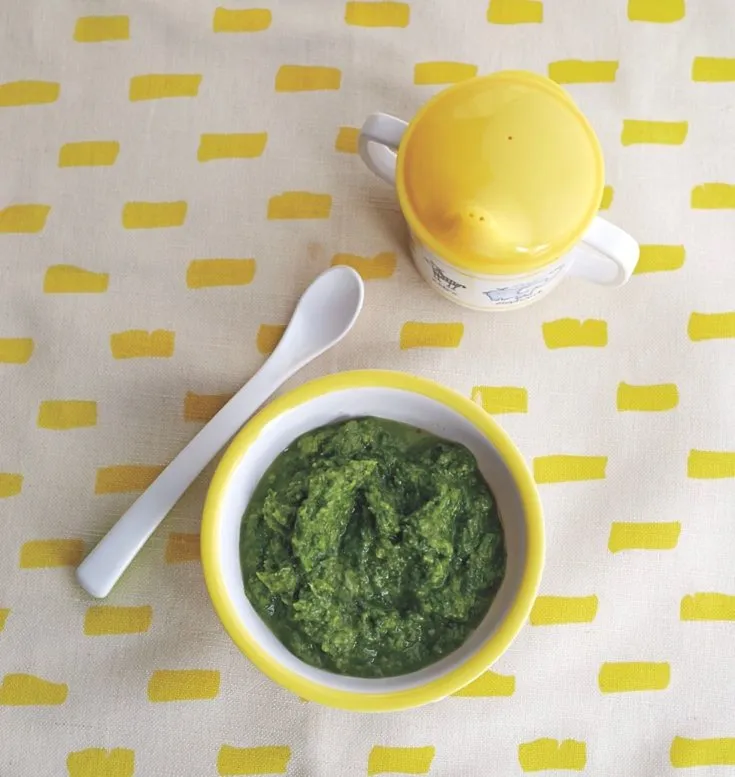
Source: Pinterest
Creamy lentil and spinach puree is a nutritious meal for babies, rich in iron and protein. Here’s how to prepare it.
Ingredients
- Spinach leaves – 1 cup
- Red lentils – 1 cup (rinsed)
- Garlic clove – 1 (minced)
- Olive oil – 1 tbsp
- Water
How to Make
- In a saucepan, heat the olive oil over medium heat. Add the minced garlic and sauté for about 1 minute.
- Add the red lentils and water to the pan. Bring to a boil, then lower the heat and simmer until the lentils are tender, about 15 minutes.
- Add the spinach leaves to the lentils in the last 5 minutes of cooking.
- Once cooked, allow the mixture to cool slightly. Then, transfer everything to a blender and puree until smooth. Serve warm to your baby.
6. Lentil, Pear, and Rice Pudding
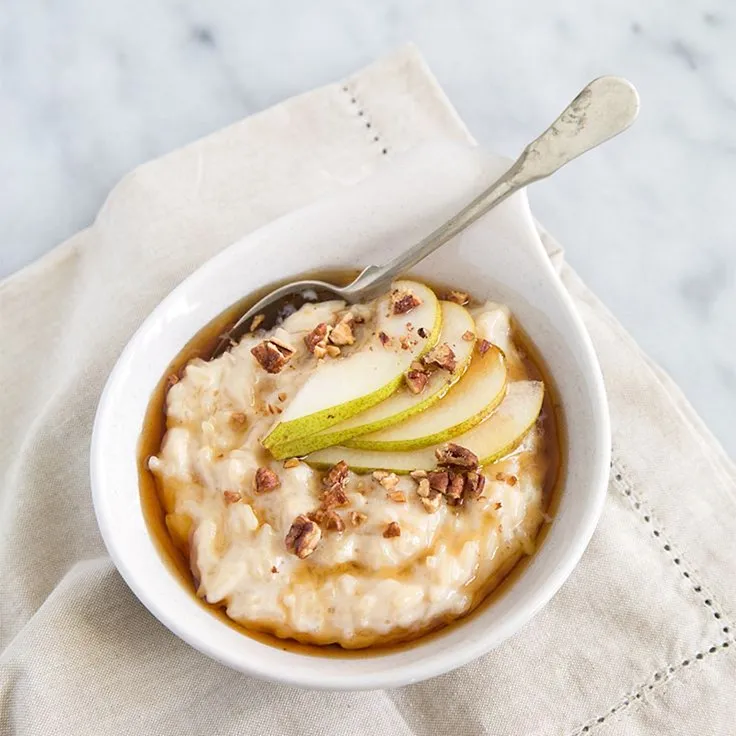
Source: Pinterest
This unique combination of lentils, pear, and rice makes a gentle, sweet pudding that’s perfect for babies transitioning to solids.
Ingredients
- Pear – 1 (peeled, cored, and chopped)
- Cooked brown rice – 1/2 cup
- Red lentils – 1/4 cup (rinsed)
- Cinnamon – A pinch (optional)
- Water
How to Make
- In a small saucepan, combine the red lentils and enough water to cover them. Bring to a boil, then reduce heat and simmer until the lentils are very soft, about 15 minutes.
- Add the chopped pear and cooked rice to the pan with the lentils. You may need to add a bit more water to prevent sticking.
- Continue to cook over low heat, stirring occasionally, until the pear is soft and the mixture has a porridge-like consistency, about 10 minutes.
- Sprinkle a pinch of cinnamon for added flavor (ensure no allergies), then allow the mixture to cool.
- Blend the mixture to a smooth or semi-smooth texture depending on your baby’s eating stage.
- Serve lukewarm, checking the temperature to make sure it’s safe for your baby.
FAQs
1. How can I enhance the nutritional value of lentils when serving them to my baby?
To enhance the nutritional value, consider pairing lentils with vitamin C-rich foods like tomatoes or bell peppers, which can help increase the absorption of iron from the lentils. Additionally, mixing lentils with a grain like rice can provide a complete protein, supplying all essential amino acids necessary for growth.
2. What are the signs that my baby may be allergic to lentils?
While lentil allergies are not as common as other food allergies, signs to watch for include hives, skin rashes, gastrointestinal discomforts such as vomiting or diarrhoea, or respiratory issues. If you observe any of these symptoms after introducing lentils, discontinue their use and consult your pediatrician.
3. Can lentils replace meat in my baby’s diet as a source of protein?
Yes, lentils can be an excellent alternative to meat as a protein source in your baby’s diet. They are rich in protein and essential nutrients like iron and folate, making them a suitable vegetarian protein source. However, ensure to complement lentils with other protein-rich foods like dairy, grains, or other legumes to ensure a balanced intake of essential amino acids.
4. How should I introduce lentils to my baby for the first time?
When introducing lentils to your baby for the first time, start with a very smooth, thin puree. Cook the lentils until they are very soft, blend them with enough water or your baby’s usual milk to create a creamy texture, and offer a small amount to see how your baby tolerates it. Initially, keep the dish simple without adding spices or complex ingredients to monitor for any adverse reactions or allergies. After your baby has successfully eaten plain lentil puree a few times, you can begin mixing it with other familiar foods to enhance flavor and nutrition.
Making lentils for baby is just as easy as it is for them to digest. Being introduced to solids for the first time is not easy on a baby’s stomach, but you can introduce lentils when your little one turns 9 months or older. Within no time, your baby will be open to trying out other food items, too.
References/Resources:
1. Chan. Y; Folate (Advances in Nutrition); National Library of Medicine; https://www.ncbi.nlm.nih.gov/pmc/articles/PMC3648733/; January 2013
2. Gammoh. N, Rink. L; Zinc in Infection and Inflammation (Nutrients); National Library of Medicine; https://www.ncbi.nlm.nih.gov/pmc/articles/PMC5490603/; June 2017
3. Lentils; Harvard T.H. Chan; https://www.hsph.harvard.edu/nutritionsource/food-features/lentils/
4. Srivastava. R, Vasishtha. H; Dietary fiber, protein and lectin contents of lentils (Lens culinaris) on soaking and cooking; ResearchGate; https://www.researchgate.net/publication/260603247_Dietary_fiber_protein_and_lectin_contents_of_lentils_Lens_culinaris_on_soaking_and_cooking; December 2013
5. Kahraman. A; Nutritional Components and Amino Acids in Lentil Varieties; ResearchGate; https://www.researchgate.net/publication/319944858_Nutritional_Components_and_Amino_Acids_in_Lentil_Varieties; December 2016
6. Beard. J; Why Iron Deficiency Is Important in Infant Development (The Journal of Nutrition); National Library of Medicine; https://www.ncbi.nlm.nih.gov/pmc/articles/PMC3415871/; December 2008
7. Lentils, mature seeds, cooked, boiled, without salt; Food Data Central; U.S. Department of Agriculture; https://fdc.nal.usda.gov/fdc-app.html#/food-details/172421/nutrients
Also Read:
Beans for Babies
When can babies eat Chickpeas
Dal Water (Dal Ka Pani) For Babies
Broccoli for Infants – Benefits and Recipes
Was This Article Helpful?
Parenting is a huge responsibility, for you as a caregiver, but also for us as a parenting content platform. We understand that and take our responsibility of creating credible content seriously. FirstCry Parenting articles are written and published only after extensive research using factually sound references to deliver quality content that is accurate, validated by experts, and completely reliable. To understand how we go about creating content that is credible, read our editorial policy here.






